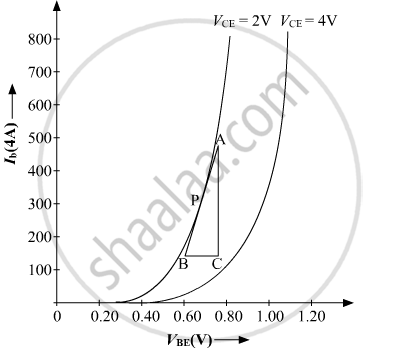Advertisements
Advertisements
प्रश्न
Define the terms : Input resistance How are these determined using typical input and output characteristics?
उत्तर
Input resistance may be defined as the ratio of small change in the base-emitter voltage (ΔVBE) to the resulting change in base current (IB) at constant collector-emitter voltage (VCE).
Input resistance, `R_i=(DeltaV_(BE))/(DeltaI_B)`

To find the input resistance, mark a point P on the input characteristic. Now, draw a tangent at point P. The reciprocal of slope of AB will give the input resistance
APPEARS IN
संबंधित प्रश्न
Write the functions of three segments of a transistor.
Draw a circuit diagram of a p-n-p transistor and explain how it works as a transistor amplifier
Draw a circuit diagram of a transistor amplifier in CE configuration.
Under what condition does the transistor act as an amplifier?
Derive an expression for voltage gain of the amplifier and hence show that the output voltage is in opposite phase with the input voltage.
Draw a circuit diagram for studying the input and output characteristics of a n-p-n transistor in common emitter configuration. Using the circuit, explain how input, output characteristics are obtained
Figure shows a block diagram of a detector for amplitude modulated signal. Identify the boxes ‘X’ and ‘Y’ and write their functions.

Draw a circuit diagram for the common emitter transistor amplifier. What is meant by phase reversal?
Write the truth table of the following circuit. Name the gate represented by this circuit.

In common emitter amplifier, the current gain is 62. The collector resistance and input resistance are 5 kΩ and 500 Ω respectively. If the input voltage is 0.01 V, the output voltage is:
